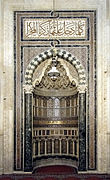- Mihrab
-
Arab World 
This article is part of the series:
Arab CultureCalligraphy- Architecture
- Textiles
- Khayameia
- Arabic Rugs
- Prayer rug
- Black Stone

Part of a series on
Islamic culture
Architecture Arabic · Azeri
Indo-Islamic · Iwan
Moorish · Moroccan · Mughal
Ottoman · Persian · Somali
Sudano-Sahelian · TatarArt Calligraphy · Miniature · Rugs
Dress Abaya · Agal · Boubou
Burqa · Chador · Jellabiya
Niqab · Salwar kameez · Taqiya
kufiya · Thawb · Jilbāb · HijabHolidays Ashura · Arba'een · al-Ghadeer
Chaand Raat · al-Fitr · al-Adha
Imamat Day · al-Kadhim
New Year · Isra and Mi'raj
al-Qadr · Mawlid · Ramadan
Mugam · Mid-Sha'ban
al-TaiyyabLiterature Arabic · Azeri · Bengali
Indonesian · Javanese · Kashmiri
Kurdish · Persian · Punjabi · Sindhi
Somali · South Asian · Turkish · UrduA mihrab (Arabic: محراب pl. محاريب maharib) is semicircular niche in the wall of a mosque that indicates the qibla; that is, the direction of the Kaaba in Mecca and hence the direction that Muslims should face when praying. The wall in which a mihrab appears is thus the "qibla wall."
Mihrabs should not be confused with the minbar, which is the raised platform from which an Imam (leader of prayer) addresses the congregation.
Contents
History
The word mihrab originally had a non-religious meaning and simply denoted a special room in a house; a throne room in a palace, for example. The Fath al-Bari (p. 458), on the authority of others, suggests the mihrab is "the most honorable location of kings" and "the master of locations, the front and the most honorable." The Mosques in Islam (p. 13), in addition to Arabic sources, cites Theodor Nöldeke and others as having considered a mihrab to have originally signified a throne room.
The term was subsequently used by the Islamic prophet Muhammad to denote his own private prayer room. The room additionally provided access to the adjacent mosque, and the Prophet would enter the mosque through this room. This original meaning of mihrab - i.e. as a special room in the house - continues to be preserved in some forms of Judaism where mihrabs are rooms used for private worship. In the Qur'an (xix.12), the word mihrab refers to a sanctuary/place of worship.[1]
During the reign of the Uthman ibn Affan (r. 644-656), the Caliph ordered a sign to be posted on the wall of the mosque at Medina so that pilgrims could easily identify the direction in which to address their prayers (i.e. that of Mecca). The sign was however just a sign on the wall, and the wall itself remained flat. Subsequently, during the reign of Al-Walid ibn Abd al-Malik (Al-Walid I, r. 705-715), the Al-Masjid al-Nabawi (Mosque of the Prophet) was renovated and the governor (wāli) of Medina, Umar ibn AbdulAziz, ordered that a niche be made to designate the qibla wall (which identifies the direction of Mecca), and it was in this niche that Uthman's sign was placed.
Eventually, the niche came to be universally understood to identify the qibla wall, and so came to be adopted as a feature in other mosques. A sign was no longer necessary.
The Qur'anic passage (xix.11) that refers to a minrab – "then he [i.e. Zakariya] came forth to his people from the sanctuary/place of worship" – is inscribed on or over some mihrabs.[1]
Present-day use
Today, Mihrabs vary in size, are usually ornately decorated and often designed to give the impression of an arched doorway or a passage to Mecca.
In exceptional cases, the mihrab does not follow the qibla direction. One example is the Mezquita of Córdoba, Spain that points south instead of southeast. Among the proposed explanations, there is the localization of the ancient Roman cardo street besides the old temple the Mezquita was built upon.
Gallery
Mihrabs Mihrab in the Mosque of Uqba also known as the Great Mosque of Kairouan; this mihrab dates in its present state from the 9th century, Kairouan, TunisiaThe Lotfallah Mosque in Isfahan, Iran.References
- Diez, Ernst (1936), "Mihrāb", Encyclopaedia of Islam, 3, Leiden: Brill, p. 559–565.
- Fehervari, Geza (1993), "Mihrāb", Encyclopaedia of Islam, New edition, 7, Leiden: Brill, p. 7–15.
Categories:- Mosque architecture
- Islamic architectural elements
- Architectural elements
- Islamic architecture
Wikimedia Foundation. 2010.





